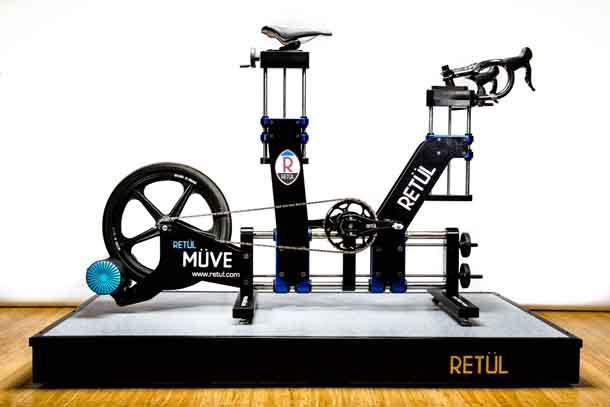LEOMO real world motion analysis unveiled
The new LEOMO Type-R device brings motion analysis to the real world and does it in a very small package. LEOMO stands for Laws and Equations Of Motion and with this new technical gadget coaches and athletes can gather and study motion analysis data during training sessions and races. 5 small Bluetooth sensors measure Dead Spot Scores, Foot Angular Range, Foot Angular Range (Q1), Leg Angular Range and Pelvic Tilt and send that data to the smart looking head unit that also can display all other pertinent cycling numbers such as power, speed, heart rate etc.
“My first thought was it is too good to be true, because that is a lot of information to track, analyze and evaluate. I had worked with USA Cycling and IBM to basically create a solution that saved significant time and provided first a rapid analysis of training data as well as a real-time analysis of all that information, and finally a real-time display going to the riders. So I knew the scale of these technology challenges, and when I first met them (having never heard of them before) I was hesitant because I had seen the power of IBM behind me and seen what that required on their side,” said coach Neal Henderson.

LEOMO was founded by professional Japanese cyclist Kunihiko Kaji and entrepreneur Taizo Son in 2012, and the company has offices in San Diego, California and Tokyo, Japan.
Motion capture analysis to date has been found in the bike fitting world by brands like Retul, Dartfish and Shimano, but the complaint has been that such motion analysis scenarios are not representative of the real world. A complaint often also voiced about wind tunnel data when it comes to aerodynamics.
The LEOMO Type-R wants to start a new paradigm. It captures motion analysis in an unobtrusive way and collects data in the same conditions the athletes train and compete in. The 5 Bluetooth sensors are worn on each knee (either under shorts or via supplied adhesive patches), each shoe (via shoe clip) and above the sacrum (via supplied adhesive patch or in jersey pocket).
“I first started using the Type R in January was trying it out myself literally just collecting the data, not even looking at it while I was riding,” continued Henderson. “I just uploaded it to the web after each ride and at first did not want to get into what I should be doing or what it should be doing. I just wanted to see it from that beginner’s eye view. During the second stage I then started to look at the data and made the connections as to what I was seeing during training sessions. Then I started to put it on other athletes to analyze their motion. I also asked them to just put it all on and record it, but to not look at it at first. “
The LEOMO Type R allows you to customize the screen where it just looks like any other head unit, showing only power, heart rate, speed etc., but not show any of the movement data if you want. Thus allowing a coach to tell the athlete to focus on the task and not the form.

Henderson continued: “I then sat down with the athlete and showed them what we were seeing in terms of movement, and in some cases it really showed a asymmetry from an easy effort on, and in other cases were we saw a breakdown in a specific motion after someone had an unsustainable power output for a certain duration and then identifying the exact change in their movement patterns. And that is now giving me a tool to objectively say ‘I want to you focus on this motion value and keep it at either more than this or less then that.’ I can add quality of movement instruction to the workout – not just output goals.“
But what does all that new data mean to the cyclist and/or coaches who purchase this product? How will it help them?
"I have been involved with this project for over a year now and the potential is incredible,” said Hunter Allen of Peaks Coaching Group. “Right now, I have a 45 page handbook that will help you to better understand all the uses for it, how to use it and explanations of the data. Just like I did for the power meter world back in 2003, I will have a step by step method to using this device that will allow any user to gain a tremendous benefit in the performance."
Neal Henderson has used the unit himself and let some of his athletes put the Type-R through the paces.
“So with the Type-R I can say to an athlete on the TT bike that I want their pelvic angle to remain between 35 and 40 degrees. Or in cases where I have seen a clear asymmetry in either foot or leg angular range, I can say during those very hard efforts I prescribe to the athlete a specific cue that on the right side I want them to maintain a 56 to 58 degrees on your leg angular range during the intervals. So they are thinking about the actual quality of the movement in addition to the output goals,” said Henderson.

The MSRP has not been announced yet for the Type-R but is rumored to be in the $700 – $800 range when the product will become available later this summer. The head unit measures 3.5 x 3.3 x 0.2-1.7 inches and weighs 84 grams with a small battery and 90 grams with the larger battery. Each of the five sensors have a dimension of 1.5 x 1.5 x 0.3 inches and weigh 12 grams. Battery life for the sensors and the head unit with the larger battery is 2 hours with the small battery or 7 hours with the extended capacity battery. The Type-R is waterproof rated to IPX7.
LEOMO also announced the Institute of Motion Analysis (IMA), a think tank research body with some of the world’s leading sports scientists, exercise physiologists, coaches, physical therapists, and biomechanics experts. Among them are Jim Martin Associate Professor, Exercise and Sport Science at the University of Utah; Neal Henderson, elite USA Triathlon and USA Cycling certified coach; Hunter Allen, elite coach and author; Dr. Inigo San Millán, Director of the Sports Performance Program at the University of Colorado’s Sports Medicine and Performance Center; and Rodger Kram, Associate Professor in the Integrative Physiology Department at the University of Colorado.






